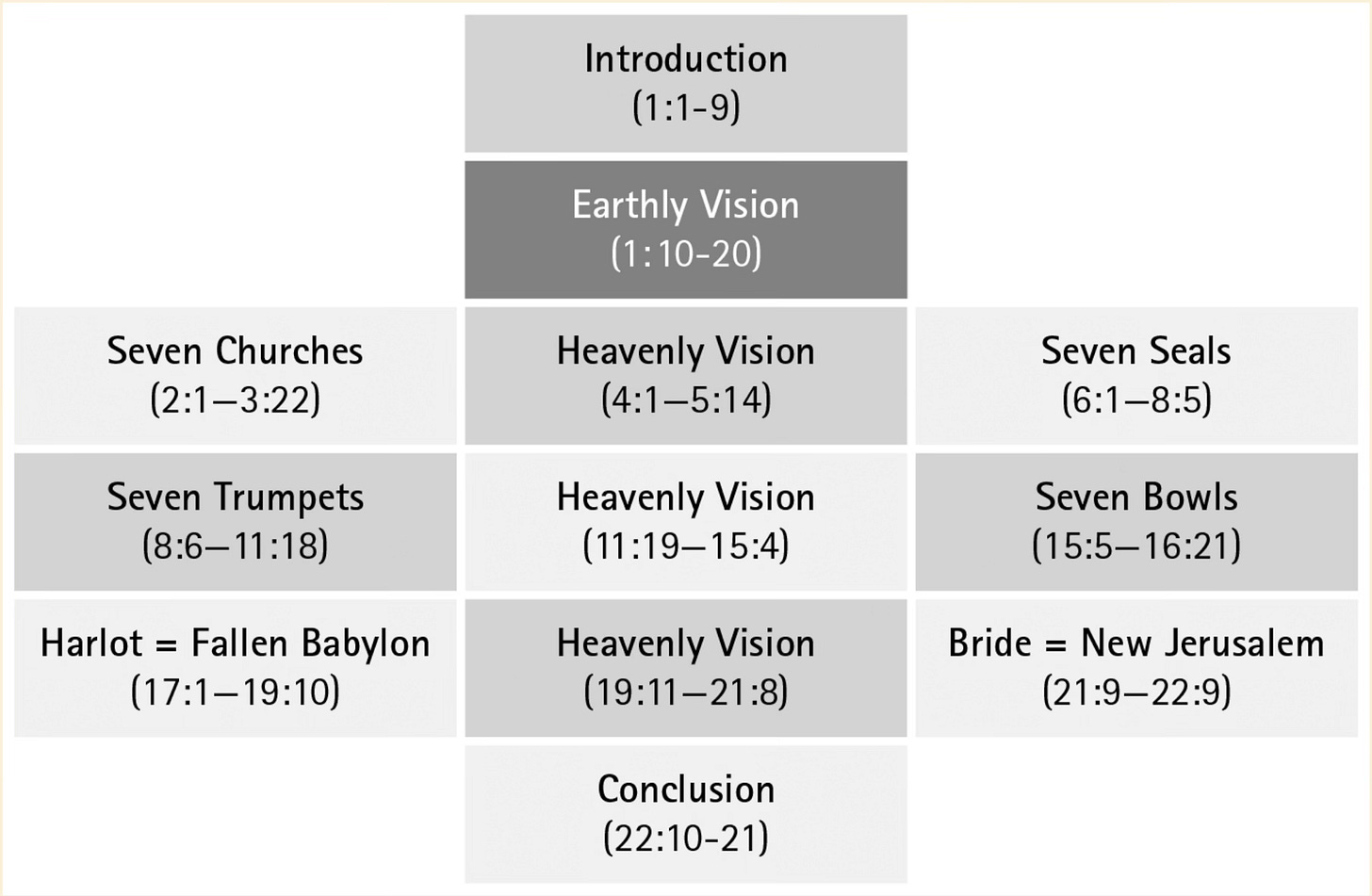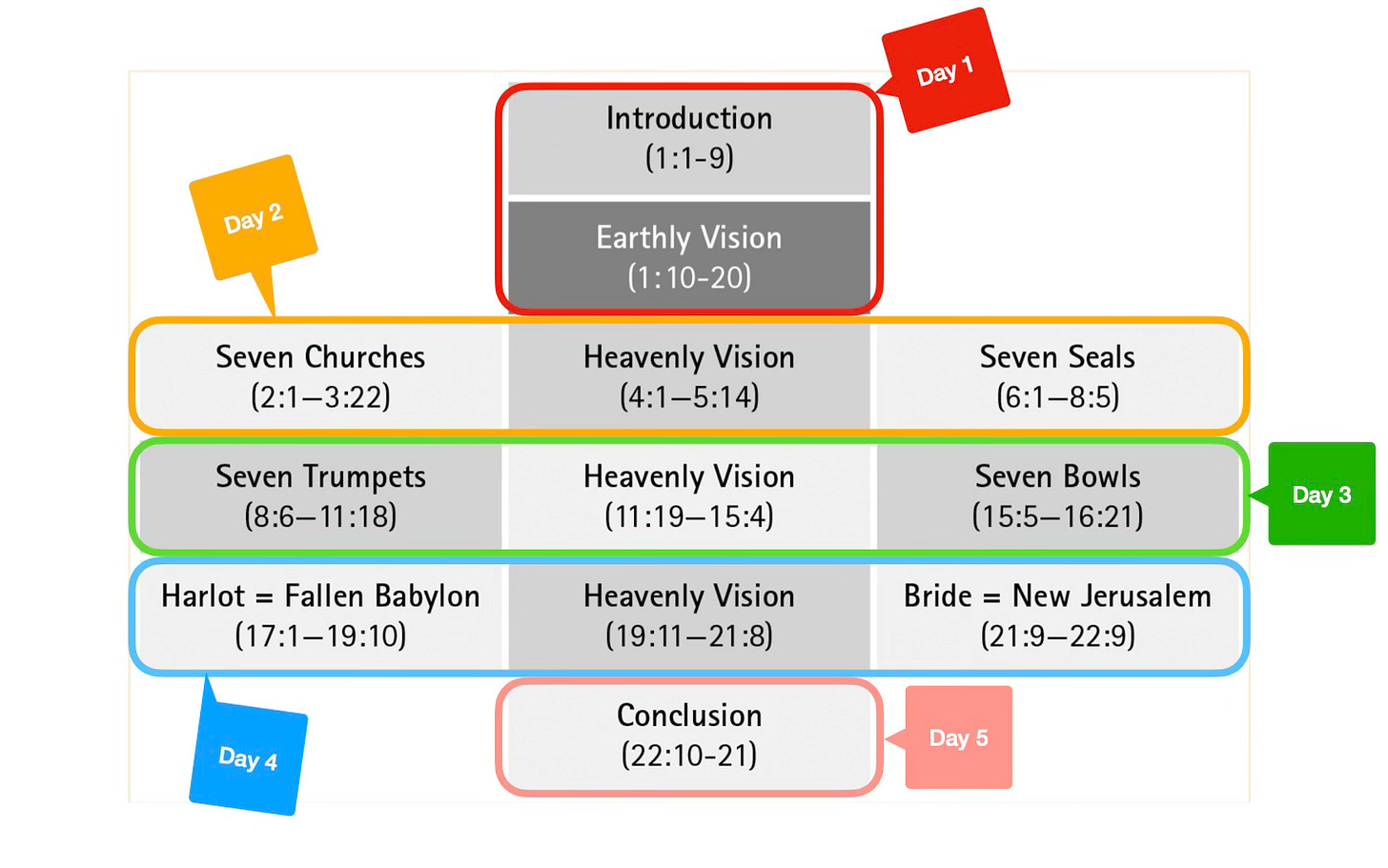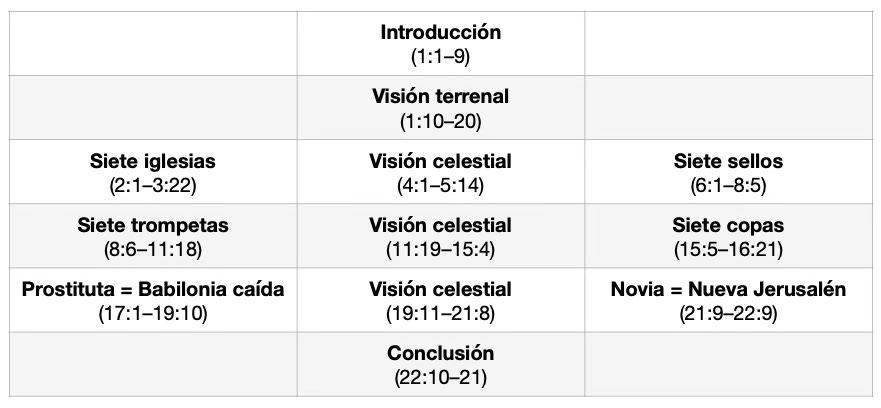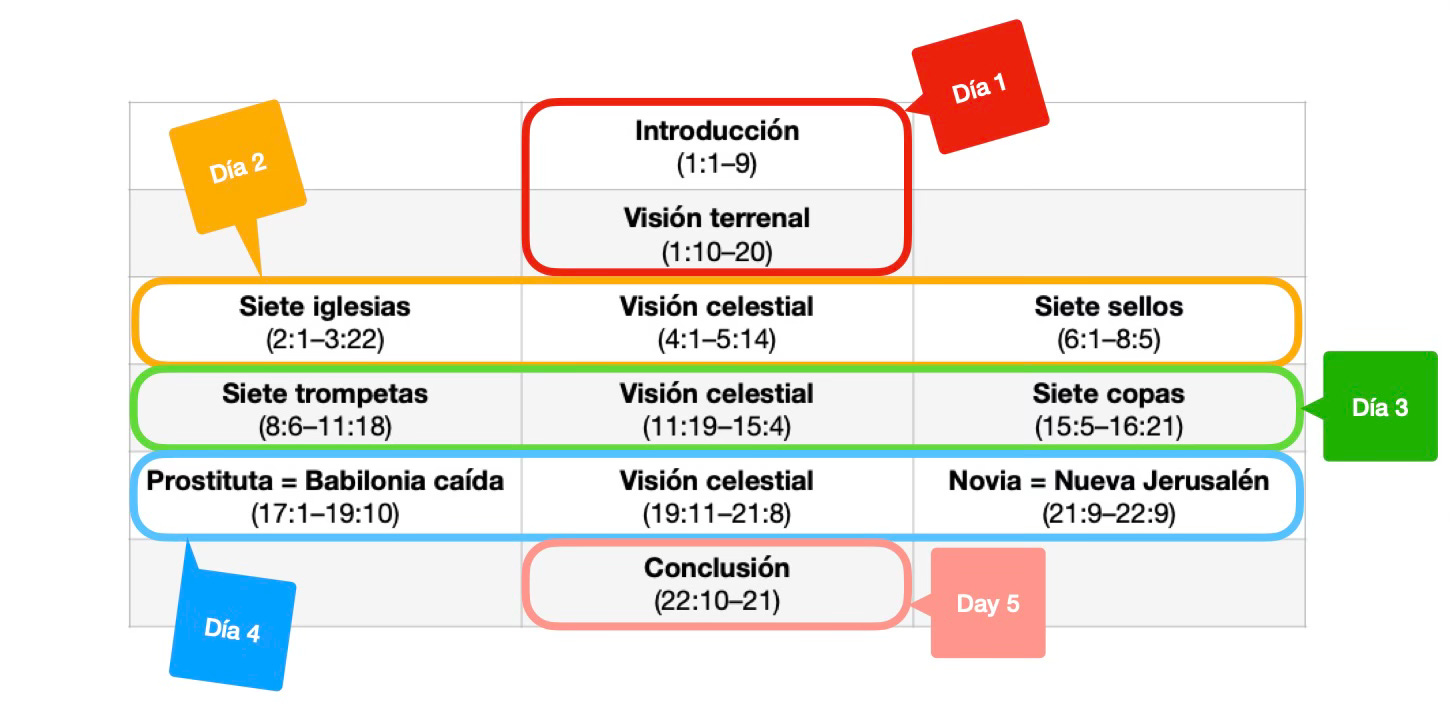A Map for Reading Revelation / Un mapa para leer el Apocalipsis
You’ve probably seen the irony in social media posts that speculate about the end times. The kind that say, “I don’t understand everything in Revelation … but are you paying attention to what’s happening in the Middle East?” What follows usually reveals a surprising certainty about details like the rapture, the mark of the beast, the Antichrist, and the coming battle of Armageddon—assumptions drawn from one specific way of reading the last book of the Bible.
It’s eye-opening for many to realize this approach comes from a very limited time and place in Christian history. To put it plainly: if you gathered Christians from every century and culture and someone shared a view having anything in common with the Left Behind books, the rest of the room could likely respond, “Ah, you must have lived in America sometime after the Civil War.”
But how can we move toward a way of reading Revelation that fits more with what John intended? It starts with three things.
First, Revelation is a book about Jesus, as it says in its opening phrase: “The revelation of Jesus Christ.” That means Revelation must be grounded in the message of Matthew, Mark, Luke, and John. If your reading of Revelation leads you to imagine a Jesus unlike the Gospels’ Jesus, something has gone off course.
Second, absorb Revelation as a whole rather than trying to solve every detail. The vivid details matter, but they can easily distract from the main point: this is a book about Jesus, calling us to follow him. That’s a very different goal than predicting the future of Middle Eastern politics.
Third, expect to be confused—and stay curious. Revelation is packed with imagery drawn from the rest of the Bible—sometimes echoing, sometimes reworking, even subverting earlier texts. Don’t let this overwhelm you. You have the rest of your life to explore these biblical hyperlinks. For now, receive the whole book, keeping Jesus—the Lamb who conquered by the cross—always in view.
So with these three starting points, how can we actually read Revelation well? If I’m going on a trip, I want a good map. Here’s one from Robert Mulholland, the New Testament scholar whose work first helped me engage with this book:
Notice I’m calling this a map, not a timeline. A timeline says one thing happens, then the next. Revelation doesn’t work that way. It reveals forces at work in John’s world under Rome—and still at work today. Mulholland compares it to a cyclorama: the kind of 360-degree painting you stand inside at a museum. You can only describe what you see in sequence, but the scene surrounds you all at once. Revelation is like that.
On this map, the outer columns—the groups of seven (churches, seals, trumpets, bowls), plus the harlot and the bride—show “past, present, and future realities of two realms of human existence: New Jerusalem and Fallen Babylon.”1 These realms are always in tension. Citizens of New Jerusalem endure tribulation in Fallen Babylon. And Babylon is disturbed by the faithful witness of New Jerusalem’s people.
At the center of the map is the book’s “core” heavenly vision—what God has done, is doing, and will do through Jesus, especially through the cross. This vision holds the whole book together.
Like any map, this one won’t make the journey simple or wholly predictable. But it can keep you oriented—and remind you that others have walked this path before.
Here are three ways to let this map guide your reading or listening:
1. One block per day
Read one of the twelve blocks each day. The shorter sections can be read in the morning and re-read in the evening.
2. Row by row (5-day plan)
This takes longer some days but can shape your understanding more deeply. Use the five-day version and read Revelation row by row, over and over. This builds a sense of its flow.
3. The whole book in one sitting (or listening)
From time to time, read or listen straight through. (It takes about 80 minutes at normal speed.) The map helps you stay oriented without getting lost in the details.
Try any of these approaches several times—and notice what stirs in you. As I’ve said before, the urgent question of Revelation isn’t about predicting the end of the world. It’s this: Am I cooperating with Babylon—or following the Lamb? Read and notice how this book makes you want to live differently in light of that question.
Un mapa para leer el Apocalipsis
Probablemente hayas visto la ironía en las publicaciones de las redes sociales que especulan sobre el fin de los tiempos. Del tipo que dice: «No entiendo todo lo que dice el Apocalipsis... pero ¿estás prestando atención a lo que está pasando en Oriente Medio?». Lo que sigue suele revelar una sorprendente certeza sobre detalles como el rapto, la marca de la bestia, el Anticristo y la próxima batalla del Armagedón, suposiciones extraídas de una forma específica de leer el último libro de la Biblia.
Para muchos resulta revelador darse cuenta de que este enfoque proviene de un momento y un lugar muy concretos de la historia cristiana. Para decirlo sin rodeos: si reunieras a cristianos de todos los siglos y culturas y alguien compartiera una opinión similar a la de los libros de Dejado Atrás, es probable que el resto de los presentes respondieran: «Ah, eres un Americano quien vivía en algún momento después de la Guerra Civil».
Pero, ¿cómo podemos avanzar hacia una forma de leer el Apocalipsis que se ajuste más a lo que Juan pretendía? Hay que empezar por tres cosas.
En primer lugar, el Apocalipsis es un libro sobre Jesús, como dice en su frase inicial: «La revelación de Jesucristo». Eso significa que el Apocalipsis debe basarse en el mensaje de Mateo, Marcos, Lucas y Juan. Si tu lectura del Apocalipsis te lleva a imaginar a un Jesús diferente al de los Evangelios, algo ha salido mal.
En segundo lugar, absorbe el Apocalipsis en su conjunto en lugar de intentar resolver cada detalle. Los detalles vívidos son importantes, pero pueden distraerte fácilmente del punto principal: este es un libro sobre Jesús, que nos llama a seguirlo. Ese es un objetivo muy diferente al de predecir el futuro de la política en Oriente Medio.
En tercer lugar, prepárate para sentirte confundido, pero mantén tu curiosidad. El Apocalipsis está repleto de imágenes extraídas del resto de la Biblia, a veces repitiendo, a veces reelaborando e incluso subvirtiendo textos anteriores. No dejes que esto te abrume. Tienes el resto de tu vida para explorar estos hipervínculos bíblicos. Por ahora, recibe el libro en su totalidad, manteniendo siempre a la vista a Jesús, el Cordero que venció por la cruz.
Entonces, con estos tres puntos de partida, ¿cómo podemos leer bien el Apocalipsis? Si voy a hacer un viaje, quiero un buen mapa. Aquí hay uno de Robert Mulholland, el erudito del Nuevo Testamento cuyo trabajo me ayudó por primera vez a involucrarme con este libro:
Fíjate que lo llamo mapa, no línea temporal. Una línea temporal dice que ocurre una cosa, luego otra. El Apocalipsis no funciona así. Revela las fuerzas que actuaban en el mundo de Juan bajo el dominio de Roma, y que siguen actuando hoy en día. Mulholland lo compara con un ciclorama: ese tipo de pintura de 360 grados en la que te sitúas dentro en un museo. Solo puedes describir lo que ves en secuencia, pero la escena te rodea de golpe. El Apocalipsis es así.
En este mapa, las columnas exteriores —los grupos de siete (iglesias, sellos, trompetas, copas), más la prostituta y la novia— muestran «las realidades pasadas, presentes y futuras de dos reinos de la existencia humana: la Nueva Jerusalén y la Babilonia caída»(1). Estos reinos están siempre en tensión. Los ciudadanos de la Nueva Jerusalén soportan tribulaciones en la Babilonia caída. Y Babilonia se ve perturbada por el testimonio fiel del pueblo de la Nueva Jerusalén.
En el centro del mapa se encuentra la visión celestial central del libro: lo que Dios ha hecho, está haciendo y hará a través de Jesús, especialmente a través de la cruz. Esta visión es el hilo conductor de todo el libro.
Como cualquier mapa, este no hará que el viaje sea sencillo ni totalmente predecible. Pero te ayudará a orientarte y te recordará que otros han recorrido este camino antes que tú.
Aquí hay tres maneras de utilizar este mapa como guía para su lectura o escucha:
1. Un bloque por día
Lea uno de los doce bloques cada día. Las secciones más cortas se pueden leer por la mañana y volver a leer por la noche.
2. Fila por fila (plan de 5 días)
Esto lleva más tiempo algunos días, pero puede profundizar tu comprensión. Utiliza la versión de cinco días y lee el Apocalipsis fila por fila, una y otra vez. Esto te ayudará a comprender mejor su estructura.
3. El libro completo de una sola vez (o escuchándolo)
De vez en cuando, léelo o escúchalo de principio a fin. (Tarda unos 80 minutos a velocidad normal). El mapa te ayuda a mantenerte orientado sin perderte en los detalles.
Prueba cualquiera de estos enfoques varias veces y observa qué te inspira. Como he dicho antes, la pregunta urgente del Apocalipsis no es sobre predecir el fin del mundo. Es esta: ¿Estoy cooperando con Babilonia o siguiendo al Cordero? Lee y observa cómo este libro te hace querer vivir de manera diferente a la luz de esa pregunta.
Mulholland, 461.




